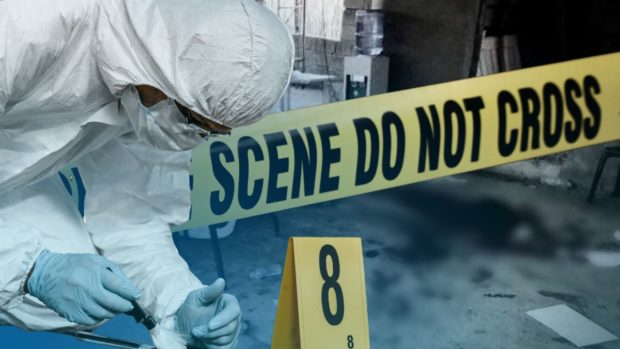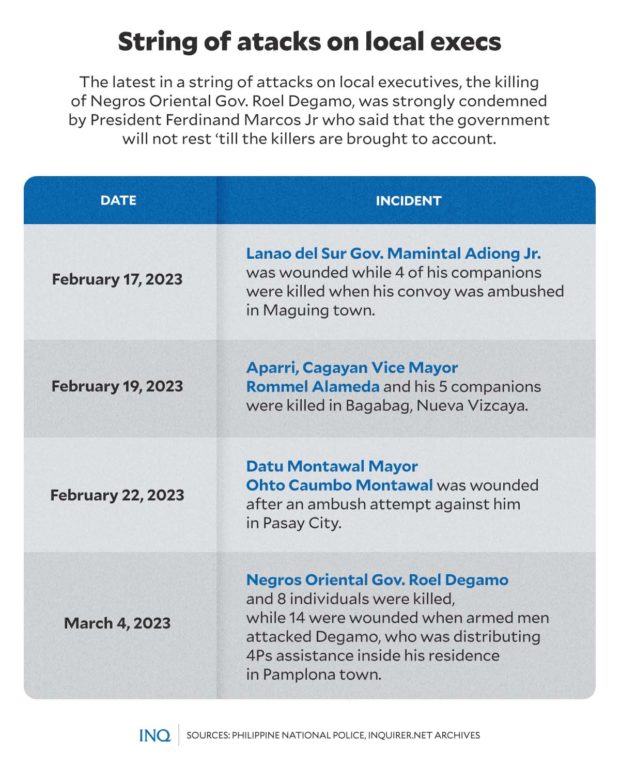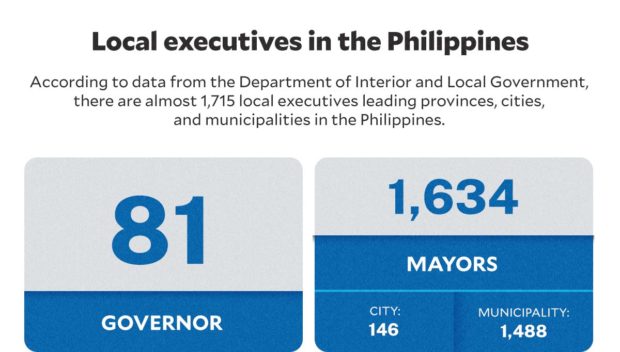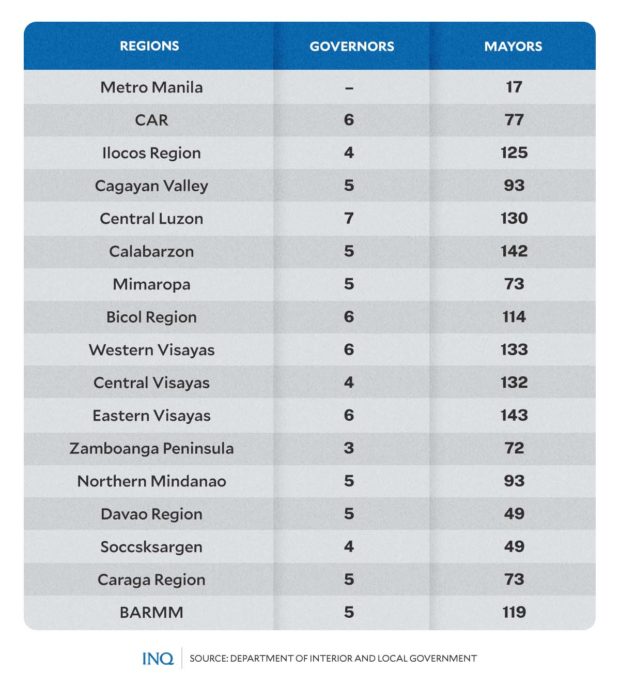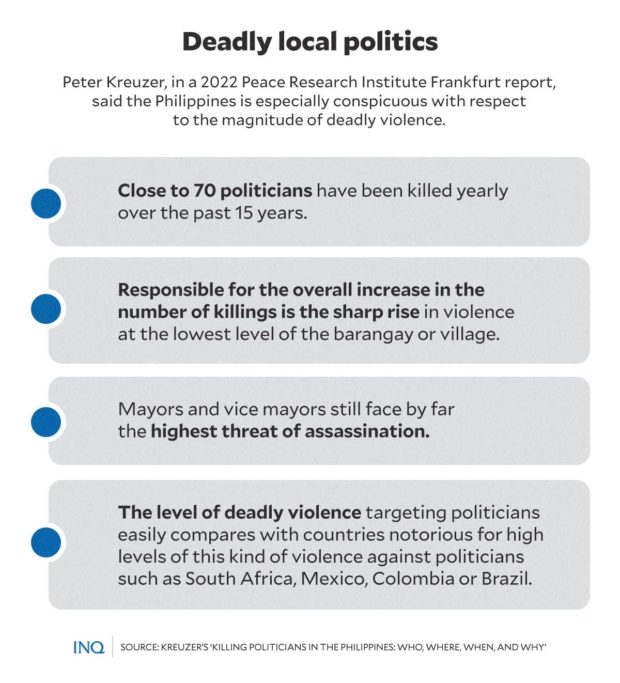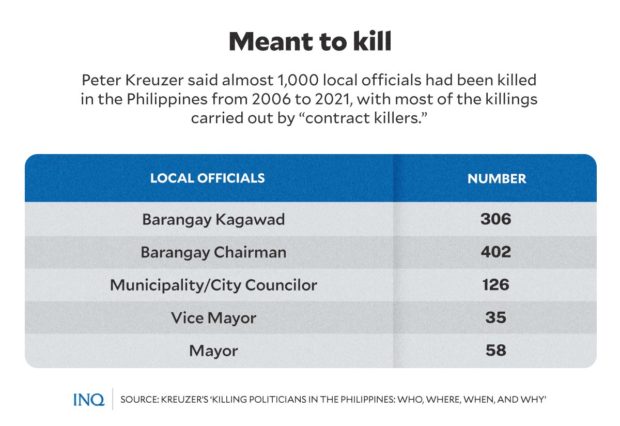Impunity in full display: Attacks on LGU execs escalate in PH
MANILA, Philippines—With close to 70 politicians killed every year over the past 15 years, the Philippines is especially “conspicuous” with respect to the magnitude of deadly political violence.
This was revealed by Dr. Peter Kreuzer in a 2022 Peace Research Institute Frankfurt (PRIF) report, saying that the violence to which politicians have fallen victim for decades has received little to no attention.
Kreuzer stated in the report “Killing Politicians in the Philippines: Who, Where, When, and Why” that with violence intensifying over time, political violence-related deaths have already increased to 100 every year.
He stressed that this level of deadly violence against politicians “easily compares” with countries “notorious” for high levels of such barbarism—South Africa, Mexico, Colombia or Brazil.
As stated by Kreuzer in the 45-page report, the overall rise in deadly violence against politicians gained significant momentum when Rodrigo Duterte was president—2016 to 2022—when the average deadly attacks rose to a “staggering” 90.2 killings every year.
But even if Duterte already ended his six-year presidency, the deadly violence against politicians persists, with vicious attacks committed since last year, when Ferdinand Marcos Jr. took office to replace Duterte.
Let’s take a look.
- Mamintal Adiong Jr.
Adiong Jr., governor of Lanao del Sur, was wounded, while four of his companions were killed when his convoy, which was traversing the road between Maguing and Amai Manabilang towns, was ambushed on Feb. 17.
READ: Lanao del Sur gov Mamintal Adiong hurt in slay attempt; 4 aides dead
Col. Michele Anayron, commander of the Philippine Army’s (PA) 403rd Infantry Brigade, said the attack happened at 3 p.m. in Barangay Ragayan. Adiong, who suffered gunshot wounds, is “already out of danger.”
Last March 2, three suspects, who are still at-large, were charged with four counts of murder, three counts of frustrated murder, and multiple counts of attempted murder at the Office of the Provincial Prosecutor in Marawi City.
- Rommel Alameda
Alameda, vice mayor of Aparri, Cagayan, and his five companions were killed when armed men said to be clad in police uniforms and riding a government car attacked Alameda in Bagabag, Nueva Vizcaya on Feb. 19.
READ: Aparri vice mayor, 5 others killed in Nueva Vizcaya ambush
Based on initial investigation by the police, Alameda and his companions, including a cousin, were on their way to Pasay City to attend the 27th national convention of the Vice Mayors’ League of the Philippines.
The Police Regional Police Office 2 already created a special investigation task group to speed up the investigation on the killing of Alameda, who was shot and killed by the assailants who opened fire at his black van.
READ: Task group to probe ambush on Cagayan vice mayor, 5 aides
- Ohto Caumbo Montawal
Montawal, mayor of Datu Montawal, Maguindanao del Sur, was wounded after an ambush attempt against him in Pasay City on Feb. 22. He suffered a gunshot wound on the hip and left arm.
READ: Maguindanao town mayor hurt in ambush try in Pasay City
The Southern Police District said “one of the suspects pulled out a gun and fired toward their vehicle [then] after the incident, the suspects fled away going to Buendia, Pasay City, while the victim was rushed to Ospital ng Maynila.”
Interior Secretary Benjamin Abalos said the Philippine National Police (PNP) Station Special Investigation Team “is now focused on going after the men behind the ambush and finding out their motives.” He said several witnesses have already reached out.
- Roel Degamo
Degamo, governor of Negros Oriental, and eight individuals were killed, while 14 were wounded when armed men opened fire while he was distributing 4Ps assistance inside his residence in Pamplona town.
READ: Death toll in Negros Oriental shooting rises to 9; 14 others hurt
As Lt. Col. Gerard Ace Pelare, spokesperson of the Police Regional Office 7, said, “the perpetrators were in full battle gear when they shot the governor several times.”
Four suspects had already been arrested by forces of the Bayawan Police Station, PNP-Special Action Force and the Philippine Army. One more suspect, however, was killed after resisting arrest and trading shots with the police and the military.
READ: Negros Oriental governor shot dead inside his house
‘Culture of impunity’
The killing of Degamo, which is now considered as the latest in a string of attacks against local elected officials, was condemned by Marcos Jr., saying that the government will not rest until the killers are brought to account.
“My government will not rest until we have brought the perpetrators of this dastardly and heinous crime to justice […] I am warning all those involved: You can run but you cannot hide,” he said on March 4.
READ: Marcos to Degamo killers: We will find you
Marcos said the investigation into the attack was “developing rapidly” and that police had already received “much information and now have a clear direction on how to proceed to bring to justice those behind this killing.”
But for Maria Ela Atienza, a political science professor at the University of the Philippines Diliman, the government has to show a strong resolve to be able to finally end the culture of violence and impunity in the Philippines.
“The culture of impunity continues because the justice system, civilian institutions, and civil society remain weak and constantly threatened. The current administration has not shown resolve in introducing reforms and enforcing laws,” she told INQUIRER.net.
Last year, the World Justice Project said while the Philippines’ standing in the Rule of Law Index slightly improved, it still remains one of the weakest in the East Asia & Pacific region.
READ: Rule of law in PH: Ranking inches up, but situation ‘gloomier’
The WJP said while adherence to the rule of law fell to 61 percent—85 out of 140 countries—in 2022, the Philippines went against the trend as it leaped from 102 in 2021 to 97 in 2022, with a score of 0.47, slightly higher than last year’s 0.46.
However, even if the Philippines is now 97th in rule of law, it remains one of the weakest in the region—13 out of 15—and was only ahead of Myanmar and Cambodia, which received a rating of 0.36 and 0.31, respectively.
As Atienza said, “the government is still weak in terms of enforcement, peace and order remains problematic [and] the traditional politics of guns, goons and gold plus weak institutions that created the dominant political elite continues.”
She stressed on Monday (March 6) that the government has to act, saying that it has to show resolve not only in addressing the killings of politicians but all types of killings and victims.
There’s a problem, though.
“How can we expect these reforms and resolve to end the culture of impunity when the dominant political elites thrive in the current environment of impunity, poor rule of law, weak democratic institutions, threatened opposition, and lack of access to justice?”
‘Almost exclusively’ local politicians
As stressed by Kreuzer, deadly violence against politicians have increased over time, so that in recent years, there have been more than 100 deaths every year, with targets “almost exclusively” local politicians.
He said responsible for the overall increase in the number of killings is a sharp increase in violence at the lowest level of the barangay, whereas deadly violence at the municipality level remained largely stable throughout the period.
“Vice mayors and mayors still face by far the highest threat of assassination,” he said.
Kreuzer said from 2006 to 2021, there have been 945 elected officials killed, 927 of which were officials in the barangays, municipalities and cities: 708 were either barangay kagawad or chairmen, while 219 were either councilors, vice mayors, and mayors.
“However, by proportion of officeholders the municipal level is clearly more dangerous than the barangay level for politicians,” he said.
He explained that given that there are only about 1,500 municipalities and independent cities but approximately 42,000 barangays with more than 330,000 elected barangay officials, it is clear that the rate of killings of chief executives at the municipality level far exceeds all others.
“The distribution within the levels shows that the respective decision-makers, barangay captains and mayors are disproportionately affected by the violence,” he said.
Kreuzer revealed that the yearly victimization rate is estimated to be 8 per 100,000 elected positions and year for barangay councilors, 76 for barangay chairmen, 89 for municipality councilors, 227 for vice mayors, and 417 for municipality and city mayors.
“Stated simply, the chance of a vice mayor or mayor dying a violent death while in office is approximately four to ten times the homicide rates of the world’s most violent states, which generally fluctuate between 40 to 50 per 100,000 inhabitants,” he said.
He stated that “such officials have been more than 20 to 40 times more likely to suffer a violent death than the average homicide rate in the Philippines over the past decade, which stood at approximately 10 deaths per 100,000 inhabitants.”
TSB
